Met with Alex and Soren to talk about the final 2 minute video about our project. Coming along well…
Been working on the actual prototype as well:


Met with Alex and Soren to talk about the final 2 minute video about our project. Coming along well…
Been working on the actual prototype as well:


Group meeting to talk about propositions for our observations and interviews with Anita from SVEF. It seems like we were not very clear on how high level, theoretical or far fetched could the propositions be.
Anastasia then showed hers and it clicked for me… we have to make claims about the topic at hand that can be supported by direct evidence such as quotes, observations, documentation.
Not to mention the fact that we had not done the actual coding – we had come up with the coding scheme but had not collected the evidence yet.
I went ahead and did it and must say the theory did emerge in situ (insert citation here 🙂 – grounded theory in action.
Here’s the coding, followed by the propositions:
How do third party organizations facilitate productive technology adoption practices between schools and education technology companies?
Conflict of interests amongst stakeholders challenges the implementation of ed tech.
SVEF has stronger relationships with teachers than with decision makers.
Very fruitful discussion about situated learning and Legitimate Peripheral Participation.
Reading Czar’s activity was to to learn Slovenian. Half the group went outside to learn by speaking. I stayed in the group that was not allowed to talk and had only text to study from.


Second half of the class we hear from Shuli Gilutz, LDT & PhD from Tel-Aviv University, Israel about her journey.
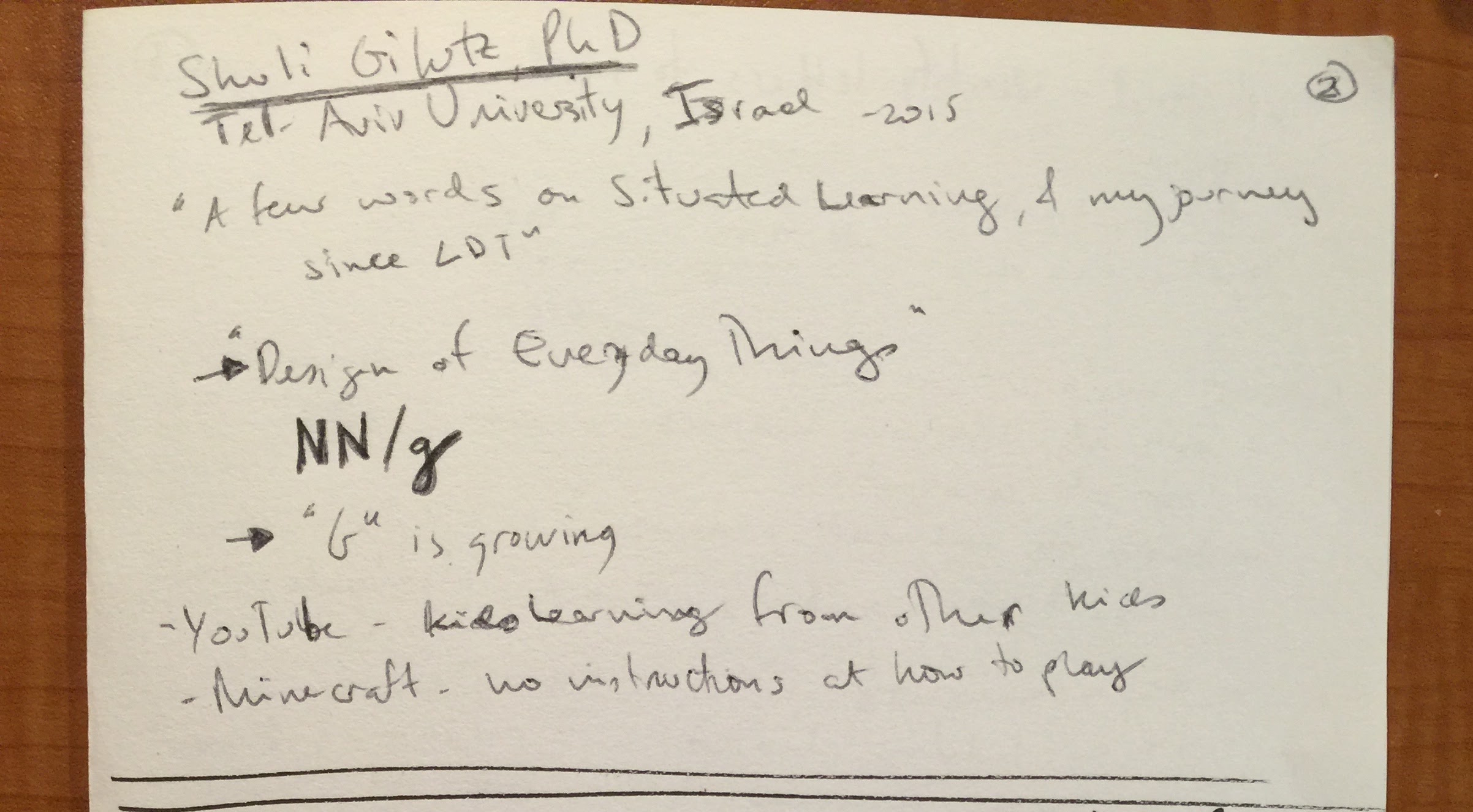
Assignment
“Situated Learning” by Jean Lave & Etienne Wenger – dense!
Response
“Viewing learning as legitimate peripheral participation means that learning is not merely a condition for membership, but is itself an evolving form of membership. We conceive of identities as long-term, living relations between persons and their place and participation in communities of practice. Thus identity, knowing, and social membership entail one another.” (Lave & Wenger, Ch. 2)
This conceptual lens of viewing learning as a social practice remits to the concept of collective consciousness (Durkheim, E., 1893) and collective intelligence. It places knowledge in the ether between practitioners and apprentices, within their interactions, and along their life cycle. Learning should not to be viewed as a mechanical process of internalization, but as a social and interactive process within a space and context.
When thinking about education technologies, one might want pay closer attention to social interaction affordances their product might offer. How can a newcomer begin to interact with older members. What are the norms and rules of engagement made available to promote learning as a communal process? How can the learner interact with others in novel ways that will promote legitimate peripheral participation?
Talked about what we have learned in this process of designing for a real person, and what we will have to present at the end of the quarter… wow… quarter is almost over!
Talked to Alex and Soren about our next steps for the presentation and final video.
Up to me to see how much of a high quality product I want to create…

Talked about several topics today including our Position Papers – each group listed the pros and cons of their topic and then presented to small groups that went around the class talking turns presenting and being presented to.
At the end of the class, a talk about standardized testing…

Today we hear Rebecca Tarlau talk about her upcoming book “Occupying Schools, Occupying Land: Public Education Reform and Social Movement-led Participatory Governance” – based on her ethnographic research (20 months living in MST settlements).
Very interesting to understand where the MST movement came from, how it started and how it provided help, curriculum and influence in the public schools of Brazil.
Some of her papers:
NMC Horizon Reports are published every year about global issues, trends, and initiatives in education. I read the 2015 Higher Education paper: here’s a very broad summary of the findings.

CHALLENGES
Solvable
Difficult
Wicked
TRENDS
Short-term (1-2 yrs)
Mid-term (3-4 yrs)
Long-term (5+ yrs)
TECHNOLOGIES
Short-term (1-2 yrs)
Mid-term (3-4 yrs)
Long-term (5+ yrs)
Assignment:
Choose one of the four NMC Horizon Reports for 2015 that is of interest to you. Each one has a link to the wiki where the work was produced. For your chosen report, explore the trends currently being discussed. Post 2-3 paragraphs about what trend you think might have the biggest impact on learning. Why?
Reading Notes:
I started out reading the Higher Education Report… was halfway through when I realized we were supposed to read the trends on the Wiki instead!! Oh well – very interesting reading that some time I will go back to for sure.



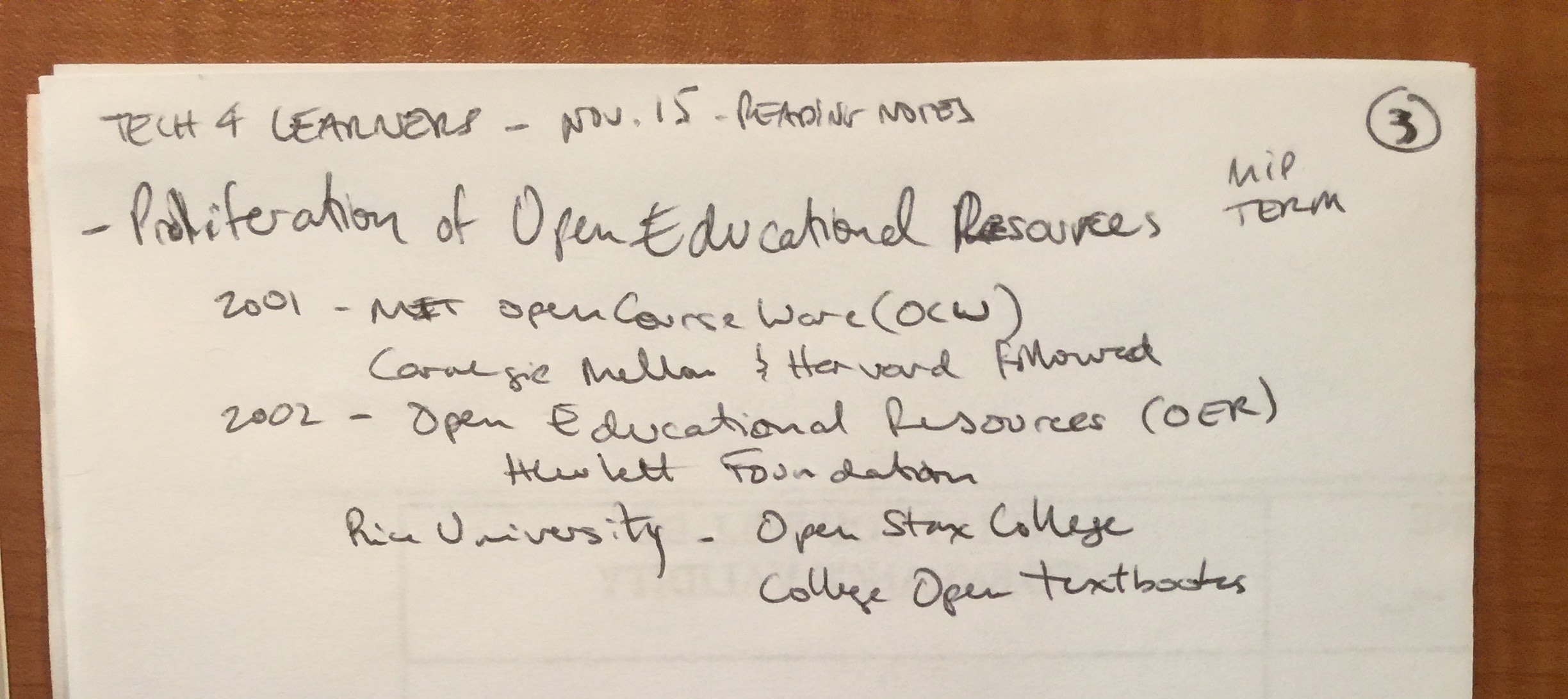
New Reading Notes: Continuing the reading (correct one now)
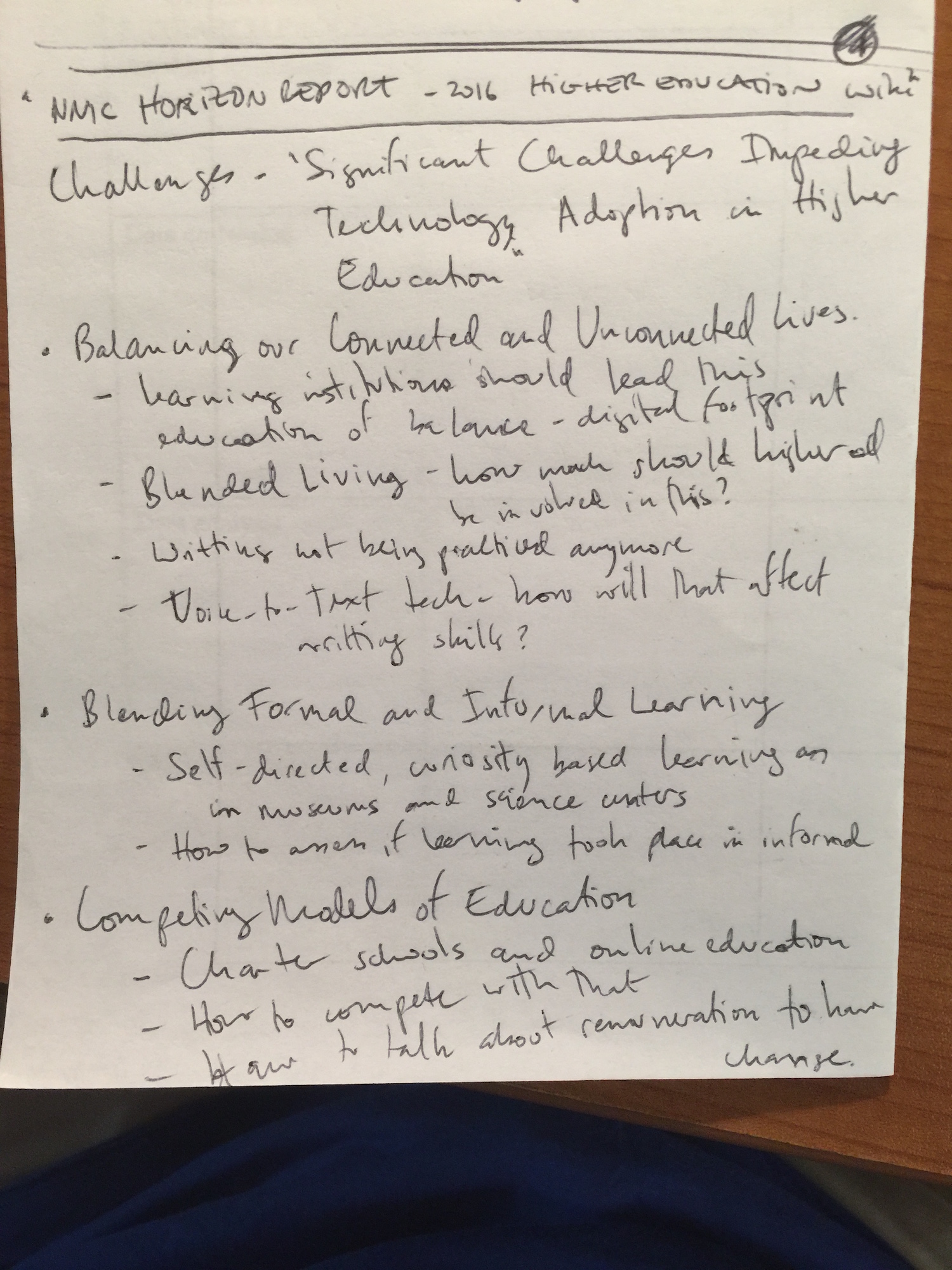

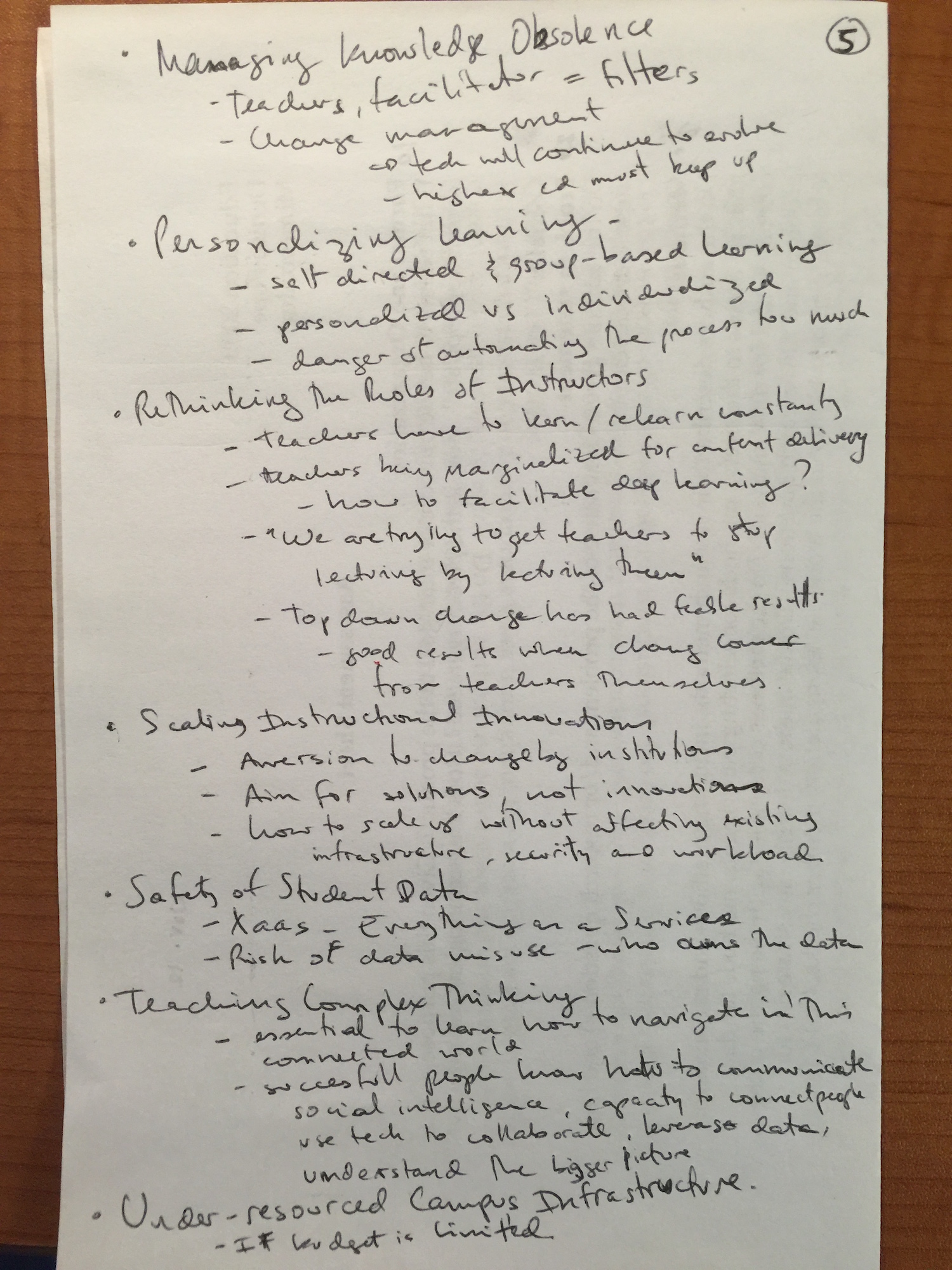
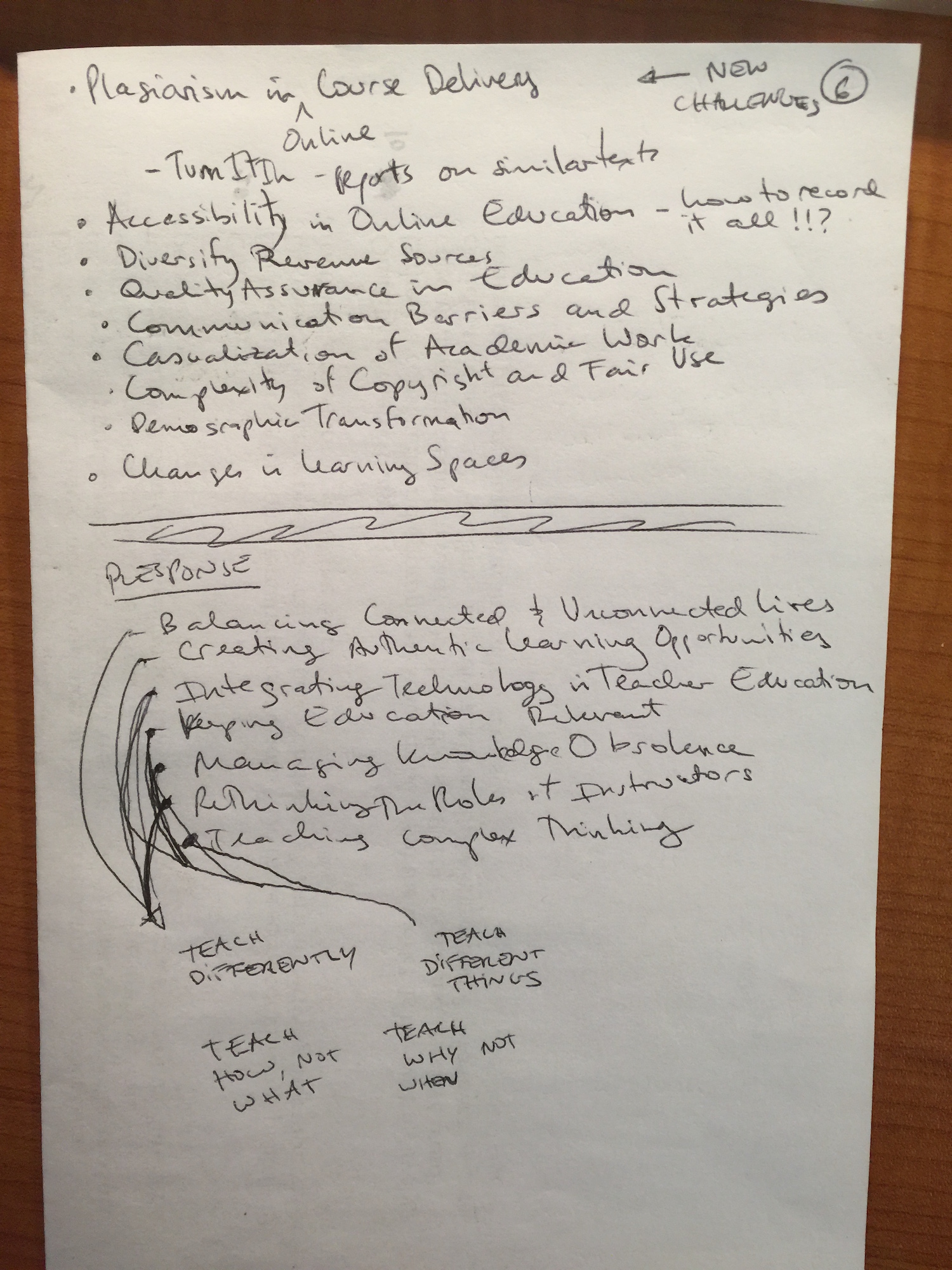
Response:
I chose to read the Higher Education report and thought that the trends that might have the biggest impact on learning can be categorized in 2 areas as I see it:
Teach Differently – look at new methods of teaching and how to use technology within the learning experiences.
Balancing Connected and Unconnected Lives
– We, as adults, teachers, and parents have trouble achieving this balance, therefore we should think about how might we teach the lessons learned to the younger generations.
– “Where we put our attention is not only how we decide what we learn, it is about how we show what we value.”
Integrating Technology in Teacher Education
– Without TPACK how can a teacher be effective with all the content and interactions available through technology their students use daily?
– Teachers must be able to understand technology and its implications to be able to use it effectively.
– “This challenge is exacerbated by the fact that digital literacy is less about tools and more about thinking, and thus skills and standards based on tools and platforms have proven to be somewhat ephemeral”
– “… teaching teachers to teach using up to date teaching pedagogies…”
Rethinking the Roles of Instructors
– Teachers become more of a guide and filter of content that a content delivery tool
– “We’re trying to get teachers to stop lecturing by lecturing to them”
Teach Different Things – look at what is being taught – is it useful or relevant, is it enough?
Creating Authentic Learning Opportunities
– Teach what you need to operate in the real world
– Teach about soft skills and well as core competencies
– “Practices such as these may help retain students in school and prepare them for further education, careers, and citizenship in a way that traditional practices are too often failing to do.”
Keeping Education Relevant
– Teach what the industry and the real world demands from students
– “The idea is to rethink the value of education as a means of reinforcing attitudes and skills learners will need to seek credible information, work effectively in teams, and persist in achieving their goals.”
Managing Knowledge Obsolescence
– How to deal with the every faster evolution of subject matters, findings, research, and beliefs.
– It’s a problem of change management – how to internalize constant external changes?
– “There is a greater need than ever for effective tools and filters for finding, interpreting, organizing, and retrieving the data that is important to us.”
Teaching Complex Thinking
– How to teach students to tackle complex problems, negotiate important matter and identify the validity of data sources.
– “The OECD report indicates the crucial need for learners to learn HOW to navigate digital texts, deal with issues of veracity and validity, and know ethical practices of using others’ work.”
To sum it up, I believe that the greatest impact in learning involve re-teaching our teachers to teach. At the same time I recognize that this is probably one of the hardest problems to resolve since it is not a matter of simply throwing money at the problem. It is about changing culture, changing daily routines, and ultimately working more, thinking harder, caring more, and valuing correctly the role of education in the world’s future.
Topic
The Politics of Teaching and Teacher Evaluation: What are the political hot-buttons in teaching? Who are the stakeholders and what are their perspectives? How should teachers be evaluated?
Assignment
Bring on a device (no need to read ahead):
National Governors Association Center for Best Practices & Council of Chief State School Officers. (2010). Common Core State Standards. Washington, DC
Reading Notes:

